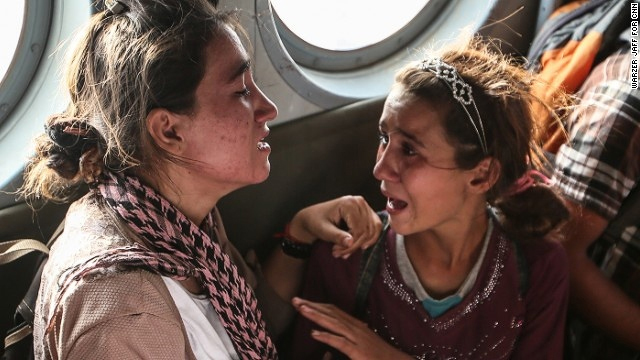The memory seems as though it is wired to store images, images that often live unpredictable lives within the psyche. Aziza, a 15-year old Yazidi Kurdish girl, has been haunting me for more than a week. Her innocent facial expression, a look of fear mingled with cognitive disorientation, continues to disturb me despite the helicopter that ferried her out of Mount Sinjar to safety. CNN’s Ivan Watson, the reporter who aided Aziza onto the chopper, is said to have become choked up with tears on several occasions. The pain one feels in this instance is less the result of politics and more that of the human condition. Perhaps the power of such images lies in their apolitical and un-contextualized nature. Their humanity trumps politics, Yazidism, Sunnism, Alawism, or Shiism.
Another enduring image which I have stored in my files is that of a man comforting a young Syrian girl who is quite obviously in near-total shock, screaming in Arabic "I am alive!" in the aftermath of Assad's chemical attacks on the city of Ghouta in August 2013. Her words suggest that the young woman has seen much death around her. As a child she is searching for a definition of death by inquiring whether she is in that state or its antithesis.
Another enduring image is one that was discussed in Geoff Dyer's essay "Echoes of Agony" in the print issue of the New Republic and "I Keep Returning to This Haunting Photo From Gaza" in the digital issue. The image taken by the photographer Finbarr O’Reilly was taken in a hospital in the aftermath of the shelling of a U.N.-run school where 16 people were killed. "But I kept coming back to this one (the picture)—partly because I couldn’t work out why I kept coming back to it," writes Dyer in his "Echoes of Agony."
Apparently, that image evoked another from the past, that prompted the author to search for it: "The answer came as soon as I stopped searching for it: Don McCullin! Specifically his picture of a Vietnamese man crouching with his back to a wall, holding a blood-soaked girl injured in the wake of a U.S. attack in Hue in 1968. The resemblance between the pictures is extraordinary—and, on reflection, completely unextraordinary: When a civilian population is bombed, pictures like this are inevitable."
John Berger (as cited by Dyer) who analyzed the more than 40-year old picture in "Photographs of Agony," offered two competing explanations: "Berger claimed that the publication of images like McCullin’s could be taken either as a sign that people “want to be shown the truth” or that growing familiarity with images of suffering was leading newspapers to 'compete in terms of ever more violent sensationalism.'"
But Berger rejects these two explanations and concludes with a third one of his own. He claims that "such pictures place events—which are the product of politics—outside the realm of the political, where they become, instead, 'evidence of the human condition.' They accuse 'nobody and everybody.'"
But Dyer's analysis of these two pictures are gloomy with regard to the prospects for a peaceful resolution of the Palestinian-Israeli conflict: "There is one crucial difference between the Gaza picture and McCullin’s: Whereas the eyes of the Vietnamese child are turned imploringly toward us, neither the Palestinian man nor the girl pay us any mind."
-- Elie Chalala, Al Jadid
Copyright © 2014 AL JADID MAGAZINE

